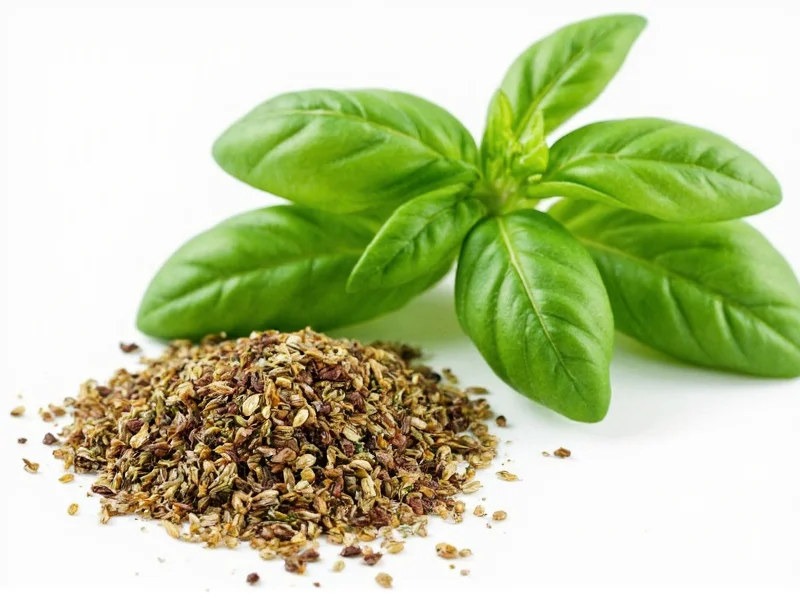Understanding herb conversions is essential for consistent cooking results. When substituting dried basil for fresh in recipes, you need to adjust measurements to maintain proper flavor balance. This guide explains the science behind the conversion, provides practical reference tools, and shares professional tips for perfect herb substitution every time.
Why the 3:1 Dried to Fresh Basil Ratio Works
During the drying process, basil loses approximately 80-90% of its water content. This concentration effect means dried basil delivers more intense flavor in a smaller volume. The essential oils and aromatic compounds become more potent when water evaporates, creating that characteristic 3:1 conversion ratio between fresh and dried forms.
Food science research confirms that dried herbs generally contain three times the flavor concentration of their fresh counterparts. This isn't unique to basil—most culinary herbs follow this same principle due to similar water content percentages in their fresh state.
Complete Dried Basil to Fresh Basil Conversion Chart
| Fresh Basil | Dried Basil | Best For |
|---|---|---|
| 1 teaspoon | ⅓ teaspoon | Finishing dishes, delicate sauces |
| 1 tablespoon | 1 teaspoon | Standard conversion for most recipes |
| ¼ cup | 1¼ tablespoons | Tomato sauces, soups, stews |
| ½ cup | 2½ tablespoons | Marinades, hearty dishes |
| 1 cup | 5 tablespoons (⅓ cup) | Large batch cooking, preserving |
When to Use Dried Basil Instead of Fresh
Chefs choose dried basil over fresh for specific culinary applications where its concentrated flavor provides advantages:
- Long-cooking dishes: Soups, stews, and braises benefit from dried basil's ability to withstand extended cooking times without losing flavor
- Dry rubs and spice blends: Dried basil integrates better with other dry ingredients
- Winter cooking: When fresh basil isn't in season or available
- Storage convenience: Dried basil maintains potency for 1-3 years when properly stored
Professional Tips for Perfect Basil Substitution
Follow these expert recommendations when converting between fresh and dried basil:
- Add dried herbs early: Introduce dried basil at the beginning of cooking to allow time for rehydration and flavor development
- Add fresh herbs late: Stir fresh basil in during the last 5-10 minutes of cooking to preserve its delicate flavor
- Adjust for age: Older dried basil loses potency—increase quantity by 25% for spices stored longer than 12 months
- Crush before using: Rub dried basil between your fingers before adding to release essential oils
- Taste as you go: Always adjust seasoning after substitution since individual palates vary
Common Substitution Mistakes to Avoid
Many home cooks make these errors when substituting dried basil for fresh:
- Using equal measurements (1:1 ratio) resulting in overpowering flavor
- Adding dried herbs too late in the cooking process
- Not accounting for the age of dried spices
- Substituting in raw applications like salads or garnishes
- Ignoring recipe context—some dishes simply require fresh basil's unique texture
Storage Tips for Maximum Flavor Preservation
Proper storage significantly impacts your dried basil's potency and affects conversion accuracy:
- Store dried basil in airtight containers away from light and heat
- Keep whole dried leaves intact until use—crush only when needed
- Replace dried herbs every 1-2 years for optimal flavor (check for faded color or weak aroma)
- Freeze fresh basil in olive oil for longer preservation while maintaining fresh-like qualities
When Fresh Basil Has No Substitute
Certain dishes absolutely require fresh basil for authentic flavor and texture:
- Pesto (the emulsion requires fresh leaves)
- Caprese salad (fresh texture is essential)
- Garnishing finished dishes
- Raw applications like fresh tomato-basil bruschetta











 浙公网安备
33010002000092号
浙公网安备
33010002000092号 浙B2-20120091-4
浙B2-20120091-4